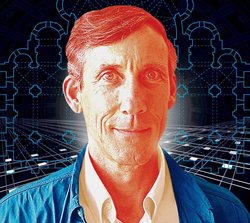George Dyson. Source of photo: online version of the NYT interview quoted and cited below.
(p. D11) BELLINGHAM, Wash. — More than most of us, the science historian George Dyson spends his days thinking about technologies, old and very new.
. . .
Though this 58-year-old author’s works are centered on technology, they often have an autobiographical subtext. Freeman Dyson, the physicist and mathematician who was a protagonist of Project Orion, is his father. Esther Dyson, the Internet philosopher and high-tech investor, is his sister. We spoke for three hours at his cottage here, and later by telephone. A condensed and edited version of the conversations follows.
. . .
. . . today you make your living as a historian of science and technology. How does a high school dropout get to do that?
Hey, this is America. You can do what you want! I love this idea that someone who didn’t finish high school can write books that get taken seriously. History is one of the only fields where contributions by amateurs are taken seriously, providing you follow the rules and document your sources. In history, it’s what you write, not what your credentials are.
For the full interview, see:
CLAUDIA DREIFUS, interviewer. “Looking Backward to Put New Technologies in Focus.” The New York Times (Tues., December 6, 2011): D11.
(Note: question bolded in original; ellipses added.)
(Note: the online version of the interview is dated December 5, 2011.)
Dyson’s most recent book is:
Dyson, George. Turing’s Cathedral: The Origins of the Digital Universe. New York: Pantheon Books, 2012.


